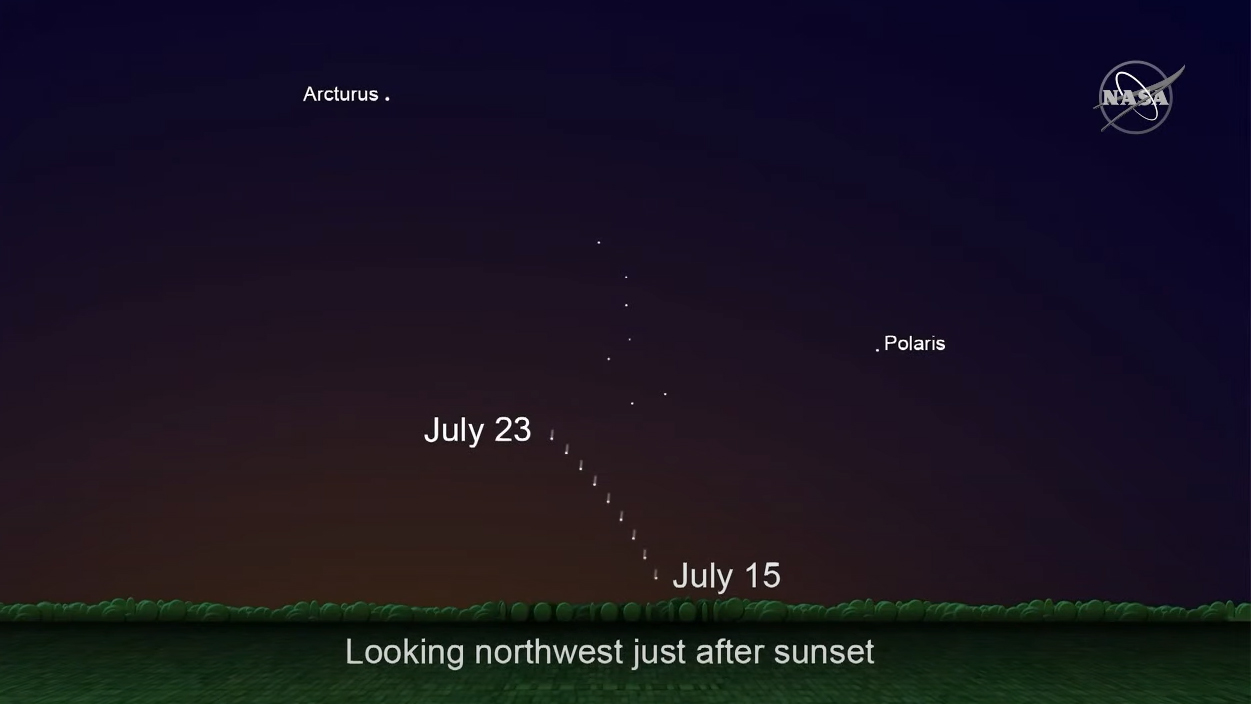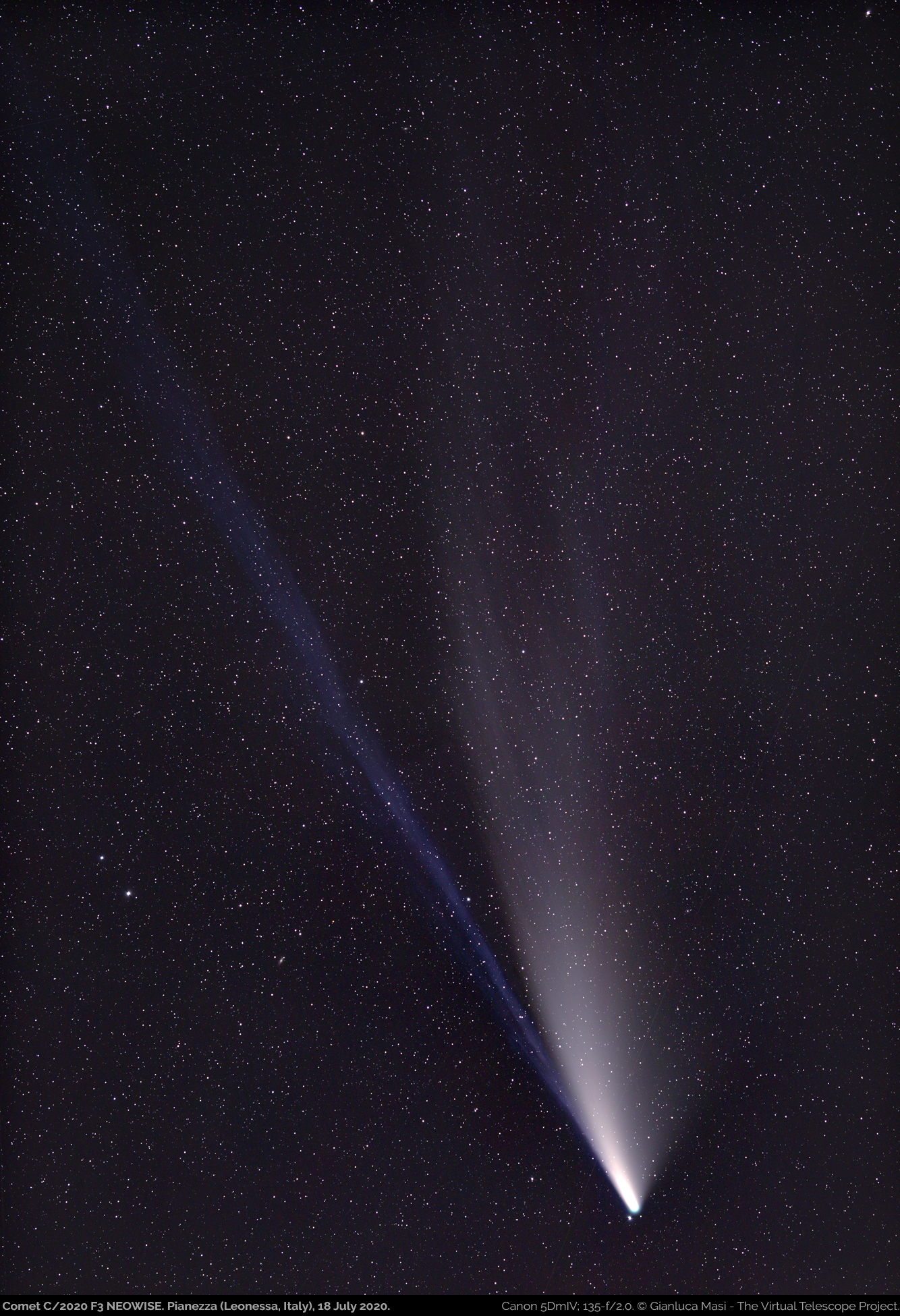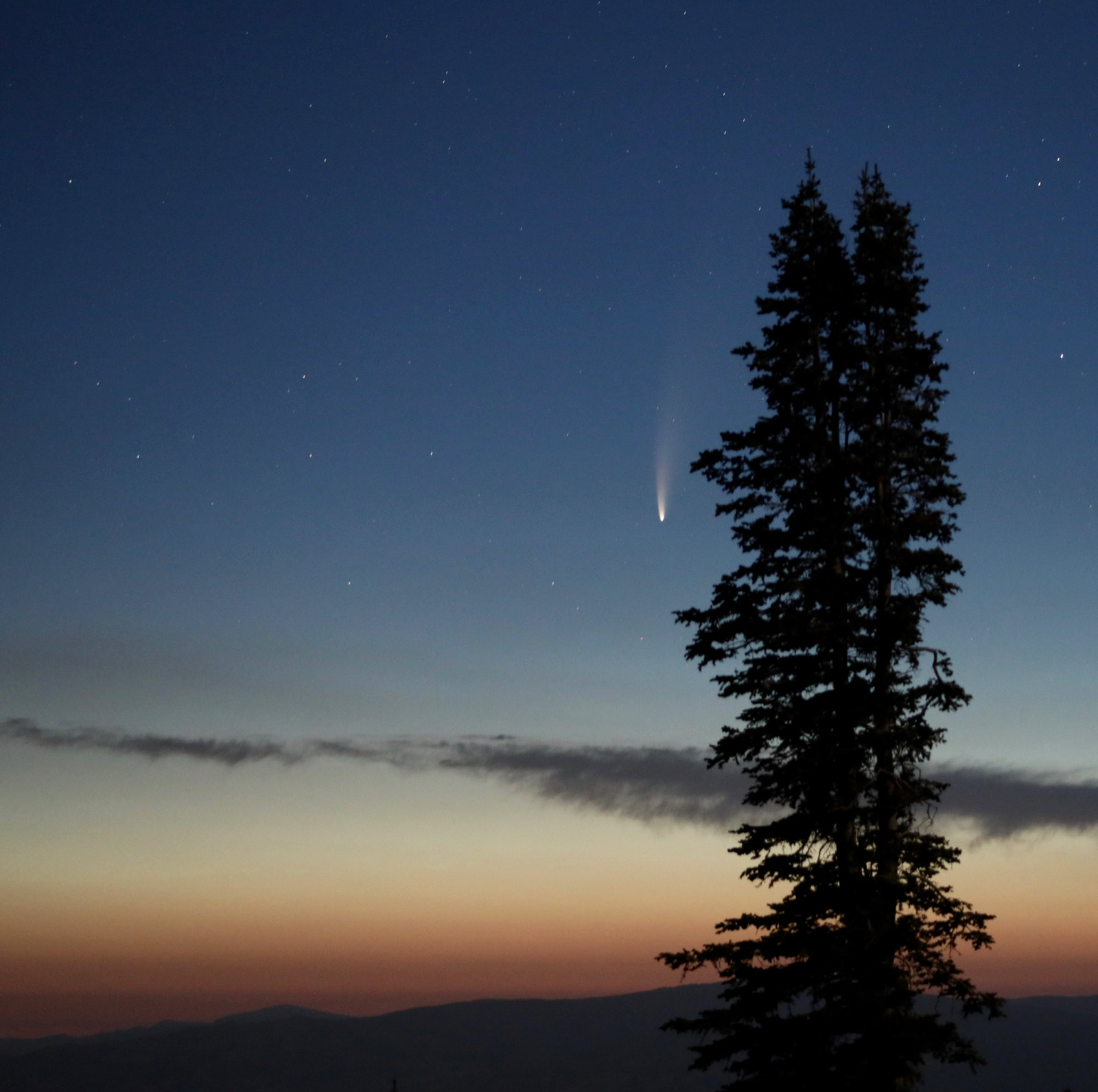Comet NEOWISE is making its closest approach to Earth. Here's how to see it live online.
The bright Comet C/2020 F3 (NEOWISE), which has garnered the attention of skywatchers around the world in recent weeks, will make its closest approach to Earth tonight (July 22).
At approximately 9:09 p.m. EDT (0109 GMT on July 23), Comet NEOWISE will reach perigee, or its closest distance to Earth. At that time, the comet will be 0.69 AU (astronomical units, or the average Earth-sun distance) away from Earth, according to NASA's orbit calculator. That's about 64.3 million miles, or 103.5 million kilometers. Shining with a magnitude of 2.2, the comet is currently about as bright as Polaris, the North Star, and can be observed in dark skies without the aid of a telescope or binoculars.
Skywatchers in the Northern Hemisphere will be able to spot the comet after sunset; it will be in the constellation of Ursa Major, just below the Big Dipper. And if you're unable to catch the naked-eye comet in the night sky during its close approach this evening, you'll have another chance to see the space rock in two live webcasts on Thursday (July 23).
Related: How to see Comet NEOWISE in the evening sky right now
More: How to spot the bright Comet NEOWISE using mobile apps

First, astrophysicist Gianluca Masi of The Virtual Telescope Project in Italy will stream live telescope views of the comet starting at 3 p.m. EDT (1900 GMT). You can watch it live here on Space.com, courtesy of The Virtual Telescope Project, or you can watch it on YouTube.
Later on Thursday, the Lowell Observatory in Flagstaff, Arizona will stream more live views of Comet NEOWISE in a webcast beginning at 11:30 p.m. EDT (0330 GMT on July 24). Hosted by Lowell Observatory director Jeff Hall and senior astronomer Dave Schleicher, the live discussion "will highlight the scientific importance of this 'dirty iceball' and how to view it," the observatory said in a statement. The Lowell Observatory's webcast will also stream live on Space.com, and on YouTube.
Related: Comet NEOWISE: Amazing photos from Earth and space
Get the Space.com Newsletter
Breaking space news, the latest updates on rocket launches, skywatching events and more!

If you haven't yet had a chance to check out Comet NEOWISE for yourself, you'll want to get a look at it sooner rather than later, as the comet has been dimming slightly over the past few days. As it slowly fades from view, the naked-eye comet will soon require telescopes or binoculars to be seen and, after it disappears, it won't be back again in our lifetime. Because of its extremely long, elliptical orbit, the comet won't be back for another 6,800 years, NASA has said.
More: Comet NEOWISE: 10 big questions (and answers)

Comet NEOWISE is currently on the outbound leg of its trip through the solar system, having swooped around the sun on July 3. At its farthest distance from the sun, called aphelion, the comet will be about 715 AU (66 billion miles, or 107 billion km) away.
Editor's note: If you snap an amazing photo or video of Comet NEOWISE and would like to share it with Space.com for a possible story or gallery, send images and comments to spacephotos@space.com.
Email Hanneke Weitering at hweitering@space.com or follow her @hannekescience. Follow us on Twitter @Spacedotcom and on Facebook.
Join our Space Forums to keep talking space on the latest missions, night sky and more! And if you have a news tip, correction or comment, let us know at: community@space.com.

Hanneke Weitering is a multimedia journalist in the Pacific Northwest reporting on the future of aviation at FutureFlight.aero and Aviation International News and was previously the Editor for Spaceflight and Astronomy news here at Space.com. As an editor with over 10 years of experience in science journalism she has previously written for Scholastic Classroom Magazines, MedPage Today and The Joint Institute for Computational Sciences at Oak Ridge National Laboratory. After studying physics at the University of Tennessee in her hometown of Knoxville, she earned her graduate degree in Science, Health and Environmental Reporting (SHERP) from New York University. Hanneke joined the Space.com team in 2016 as a staff writer and producer, covering topics including spaceflight and astronomy. She currently lives in Seattle, home of the Space Needle, with her cat and two snakes. In her spare time, Hanneke enjoys exploring the Rocky Mountains, basking in nature and looking for dark skies to gaze at the cosmos.
-
Wolfshadw Well, NO JOY on spotting NEOWISE for me, this evening. The skies finally cleared after being cloudy all day, but even though I had a clear LOS on URSA Major and below, I could not spot the comet with the naked eye (10:25 CDT). I suspect too much light pollution (Downtown Minneapolis in that direction) and my failing eyesight.Reply
I did see two unknowns, however, intersect their paths. I suspect they were satellites as at this time of night, even with low flying aircraft, about all you see are the flashing anti-collision lights.
The first I saw was a steady light, moving in a northerly direction. I've seen satellites before and this seemed to have the right speed as it crossed the sky. The other, I found more interesting because it wasn't a steady light. It did oscillate, but at such a slow rate there's no way it could have been some type of aircraft. It literally would disappear for between two and three seconds and then appear again for a second or more. A steady rate and a straight path (as with the first). My guess would be some sort of rotating satellite (or debris), occasionally reflecting sunlight down to Earth.
A rough depiction of the two object's paths:
White: Object 1 - Steady light
Yellow: Object 2 - Slowly flashing
Just nice that my brief viewing wasn't completely wasted.
-Wolf sends
Edit: And I checked. ISS was nowhere in the vicinity. -
SAFulop I saw it tonight using 9x25 Nikon binoculars intended for birdwatching. It is slightly above the Tania stars at the edge of Ursa Major, but definitely not naked eye. It was predicted in the Space.com article to be Mag 2 tonight, but I put it more like Mag 5. It was dimmer than the Tania stars which are Mag 4.Reply -
SAFulop I saw it again this evening, it's getting very faint now. My little Nikons could only help me see a fuzzy ball, but no tail was visible. It has moved considerably up and to the left from its position in Ursa Major last night, but the two Tania stars can still be used as a reference point.Reply -
Lovethrust I have a small 100mm Reflector I am bringing out tonight if the skies clear. I am getting really bummed out that I have yet to spot it.Reply -
Island_Stargazer From the island of Kauai me and my kids saw it last night. It was pretty faint, and the bright crescent moon didn't help. My kids could instantly see it, for me however, had to look at it indirectly as my eyes are getting old.Reply









